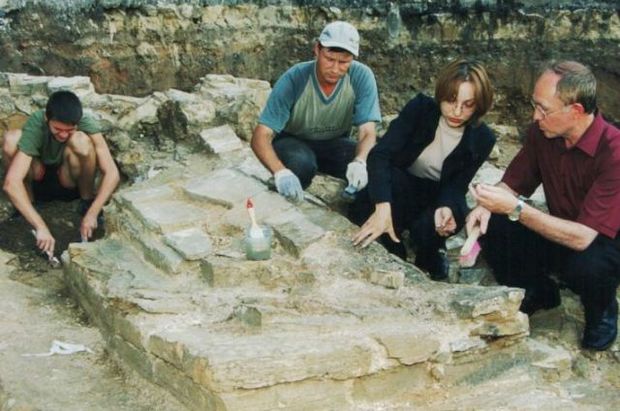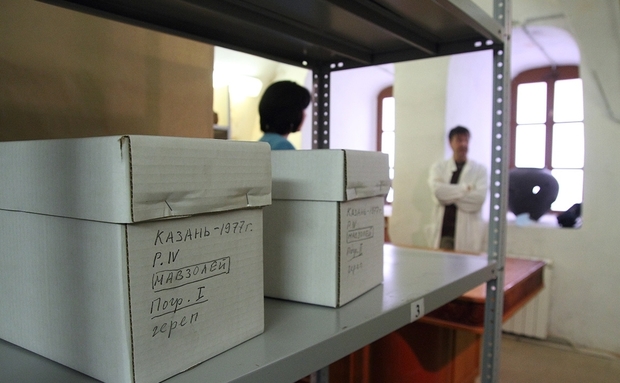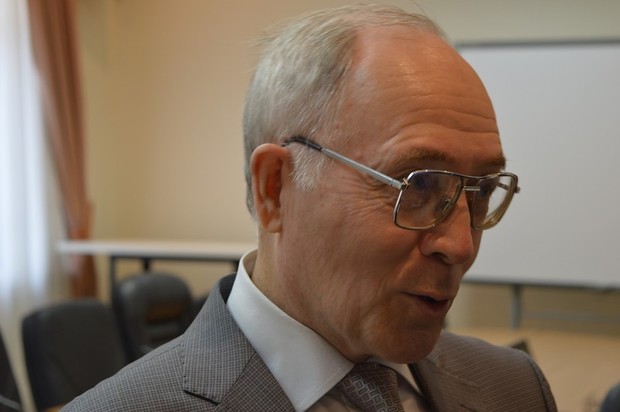Fayaz Khuzin: ‘It is blasphemy that the khan’s remains are gathering dust in the depository’
Bulldozer on the mausoleum, arguments with anthropologists and similarity of grandson with his grandfather of royal lineage
Publications on the fate of two khans' remains in Realnoe Vremya don't leave our readers cold. Even historians joined the discussion. So, apart from historian Bulat Khamudullin, deputy director on the development of the Archaeological Institute of the Academy of Sciences of the Republic of Tatarstan and Doctor of Historical Sciences Fayaz Khuzin also shared this opinion without any pathos. The remains can be exhumed again if science needs them. The archaeologist and scientist told about the detection of the remains of the Kazan rulers and their identification in an exclusive interview with our newspaper.
A two-stage research
Mr Khuzin, when and how Khans Makhmud and Mukhammed-Amin's remains were found?
Professor Alfred Khalikov was the first to find the remains of the mausoleum of the Kazan khans. He came across them by chance during construction works. He dug in the Kremlin but in another place. A bulldozer or evacuator worked near the Syuyumbike Tower and detected stones of a building. Alfred Khalikov approached and started to dig there. There was not given an opportunity to explore this place. He discovered several graves, including the latest ones. Two of them are the remains of the graves of the Kazan khans.
Who defined they were khan graves?
These graves were inside the mausoleum that was a tomb. Bones were in wooden boxes. The wood went rotten. The tombs were covered with leather, saffian or silk and detached to the boards with silver nails. It was a well-off grave. According to the Muslim ritual, their heads were faced towards Mecca and hands were put along their bodies. After the research, it might be supposed they had remains of a mausoleum on front of them. He approximately defined the age of this mausoleum. One grave dated back to the middle of the 15 th centuries, and the second – to the first half of the 16th century. Alfred Khalikov presupposed the first grave belonged to Ulug-Mukhammed or Khan Makhmud, his son, while the second grave was Safa Giray's. There was scarce data in order to identify them. It was the first stage of the research – in 1977.

'Professor Alfred Khalikov was the first to find the remains of the mausoleum of the Kazan khans. He came across them by chance during construction works.' Photo: kazan-kremlin.ru
The second stage: we dug in 2004 and 2005 years. I chaired the expedition. We almost completely discovered this building. Having studied, we found out where these graves were. We found four graves more, they are six in total. There were other ruined graves, they might refer to a later period. According to written sources, which are mainly Russian manuscripts, we know six Kazan khans were buried in Kazan: Makhmud, Khalil, Ibragim, Mukhammed-Amin, Djan-Gali (Syuyumbike's first spouse) and Safa Giray. We started to dig in 1994 but used Alfred Khalikov's materials on the digs before our works on the mausoleum. It is a very interesting topic. The materials were not published. People almost knew about them because it was just forbidden writing about Kazan khans in the Soviet era. This is why we created a commission that included archaeologists, historians, anthropologists from Moscow, Samara and our anthropologist. The anthropologists started to study the skulls of two Kazan khans first. Their initial conclusion was that not Ulug-Mukhammed, who was not in Kazan, but his son Makhmud was buried in the first grave. He ruled from 1445 to 1460. The exact data of his death is unknown. And the second grave did not belong to Safa Giray, as Khalikov supposed, but to Mukhammed-Amin because the buried person was aged about 50, and Safa Giray was about 40. The bones had signs of osteoarticular tuberculosis. According to sources, indeed, Mukhammed-Amin was sick and was not able to move.
It turned out we identified two out of the six graves. They might be Makhmutek and Mukhammed-Amin. We would like these graves to be dug in the future if not by us – by our followers.
So, did you study the other graves?
No. We found these graves but did not reach the bones.
It is necessary to use new methods and analyse their genetics. The most important thing is that they should be reburied and returned to the place where they rested. Now they are in the depository of the Archaeological Museum of Tatarstan in the Kremlin. Reburial of holy bones of the Kazan khans would be humane, though there are opponents. All our anthropologists say it's necessary to study, analyse their genetics. I say anyway we need to bury them. We can exhume them when we do a research. They can be buried so that it would be easy to take them out.

'We dug in 2004 and 2005 years. I chaired the expedition. We almost completely discovered this building. Having studied, we found out where these graves were.' Photo: kazan.aif.ru
By the way, the head of the Archaeological and Biological Laboratory of the Archaeological Institute of the Academy of Sciences of Tatarstan Ilgizar Gazimzyanov is against their burial. He thinks it has not been proved yet these remains belong to these khans.
We don't know when these research works are going to take place. Money is needed for this purpose. Meanwhile, people and society know about it. They have been addressing the state departments and us since 2005 asking to bury them as soon as possible. They are right. It is blasphemy that the remains are gathering dust in the depository. Now we can take them out, it is easy today.
'Absolutely for reburial'
How did you identify the appearance of these khans?
We have a very accurate method for restoration, reconstruction elaborated by professor Mikhail Gerasimov in the 60-70s. He restored appearances reaching almost a 100% similarity. It is called Gerasimov method. He created portraits of people who died a long time ago like Timur, Ivan the Terrible, Andrey Bogolyubsky, Vsevolod the Big Nest. Now Moscow anthropologists use his method. Tatiana Balueva was included in the working group in the 1990s. Using the khans' skulls, she easily recreated these khans' portraits. They were similar to each other. It is Makhmud and his grandson Mukhammed-Amin. Grandsons usually look like their grandfathers.
You said they were buried according to the Muslim ritual. Nevertheless, the Muslims didn't use to place a body in a grave but enshroud it in a cloth and bury it so…
It used to be so. When we dug Muslims graves of the 10 th-13th centuries in Bilyar, almost all of them were in graves, you know. It was a ritual. They might be buried in graves or without them, it was not strictly followed. The most important thing is the direction of the head or face towards Mecca and the absence of clothes. If these requirements were met, the burial was Muslim.

'The bones are under control of our anthropologists and archaeologists and kept in carton boxes… We take care of them and treat them as holy relics.' Photo: tatar-inform.ru
Is there any information of the burial of the remains?
This question is still under discussion, we are the people who should solve it. We are ready to take part if our help is needed. This problem is to be solved at a higher level. Everything remains to be discussed. It doesn't depend on us. The problem is being elaborated and studied only. Reburial is needed. It is not necessary to do it with shows.
The bones were dug in 1977. In other words, have the bones being studied for 40 years?
No, they have not being studied. They did not disappear, thanks God. Indeed, they are under control of our anthropologists and archaeologists and kept in carton boxes. I figuratively say they are gathering dust. We take care of them and treat them as holy relics. But the fact that they have been laying there for 40 years is not serious. Indeed, it would have been possible to analyse their genetics during this time. The analysis doesn't take much time. Let them do it before the burial. It is not a reason for letting them stay so. I'm absolutely for the reburial.
Goodies
Could you tell us briefly about these two khans, please?
There is not much information. We don't know for sure when Makhmutek ruled – from the beginning of the 60s of the 15 th century. Only good things are written in historical literature. The beginning is connected with a tragedy, of course. According to written sources, he came to Kazan in 1445, killed the local ruler Ali Bey and occupied the throne. There were no wars during 20 years of his ruling, peace reigned. He built a new khanate, created a well-performing state apparatus, cared about the population. Everything developed: economy, including trade, ties with Rus and the West were established, culture flourished. There were not any attacks of the Kazan or Moscow people. There was peace, love and understanding.

'There were not any wars during 20 years of his ruling, peace reigned. He built a new khanate, created a well-performing state apparatus, cared about the population.' Photo: Timur Rakhmatullin
Mukhammed-Amin reigned twice. His first term was from 1487 to 1496. He was educated at the court of Ivan III in Moscow. Consequently, he was brought up with love towards the Russians. When he started to rule, he did what he was said by Moscow. Then the penny dropped. He understood the Khanate of Kazan was an independent state, though it was under the Moscow protectorate from his ruling. So, this state had its own goals, peculiarities. It was no longer possible to rule under control of Moscow. He started to act. The Moscow knyaz did not like it – he was divested of the throne. Then he ruled from 1502 to 1518. He was an absolutely different person. He started to have nationalistic views: he did not obey Moscow, ruled on his own. There were military campaigns and battles with Moscow, of course. Nevertheless, the state developed and flourished under Mukhammed-Amin. He was not only a good diplomat and ruler but also poet. Manuscripts also prove it. His several verses and poems survived. He was close enough to the people, cared about his servants. This is why it was not a turbulent period. But then a preparation for the tragedy in 1552 began. Both Makhutek and Mukhammed-Amid went down in the history as goodies.